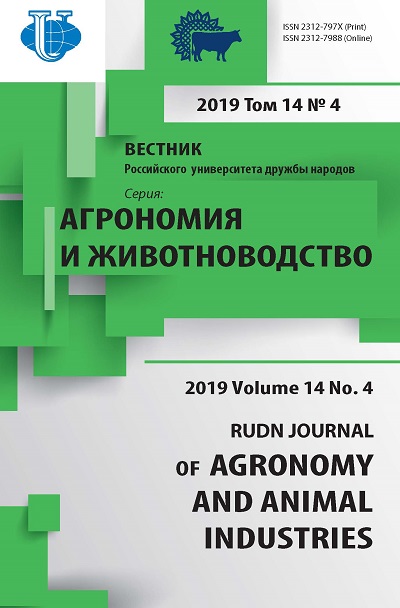Scientific support of production experiments in forest plantations of green zone in Nur-Sultan city
- Authors: Kabanova S.A1, Kabanov A.N1, Khasenov A.A2, Danchenko M.A3
-
Affiliations:
- Kazakh Research Institute of Forestry and Agroforestry
- Astana Ormany company
- Tomsk State University
- Issue: Vol 14, No 4 (2019)
- Pages: 437-452
- Section: Protective afforestation
- URL: https://agrojournal.rudn.ru/agronomy/article/view/19529
- DOI: https://doi.org/10.22363/2312-797X-2019-14-4-437-452
- ID: 19529
Cite item
Full Text
Abstract
Natural and climatic conditions of the green zone of Nur-Sultan (Kazakhstan) are unfavorable for tree and shrub species due to low soil fertility, sharply continental climate and other factors. The purpose of the research was to choose an assortment of stable introducents for Nur-Sultan green zone. The monitoring of growth and condition of artificial plantations included the selection of an assortment of stable coniferous introducents. The objects of research were coniferous introducents, which were planted in 2011 as container annual seedlings and three-year-old seedlings with open root system. According to the results of observations of conservation, taxation indicators and condition of artificial plantations, it was revealed that for the soil and climatic conditions of the research region, Picea nigra and Picea sibirica turned out to be the most adapted. Quercus robur was also characterized by good growth, but in the first years after planting, it was significantly damaged by late spring frosts and rodent ingestion. Larix sibirica , despite the fact that most of its plants died in the first years after planting, has adapted to soil and climatic conditions now and grows well enough and has a satisfactory condition. The safety of introduced plants planted with annual seedlings with a closed and open root system was practically the same and at the age of 8 it was 62.6 and 64.9%, respectively. It was revealed that it is better to plant crops with older seedlings (3-4 years old), because cultivation of annual seedlings with closed root system requires large financial and labor investments due to prolonged manual care. Therefore, to create artificial plantations in the green zone of Nur-Sultan, Picea sibirica , Picea nigra and Quercus robur can be recommended. When growing them, it is necessary to carry out thorough agro-technical cares and protection from rodents.
About the authors
Svetlana A Kabanova
Kazakh Research Institute of Forestry and Agroforestry
Author for correspondence.
Email: Kabanova.05@mail.ru
Candidate of Biological Sciences, Head of the Department of Forest Reproduction and Afforestation
Shchuchinsk, Republic of KazakhstanAndrey N Kabanov
Kazakh Research Institute of Forestry and Agroforestry
Email: 7058613132@mail.ru
Master student, Researcher, Department of Forest Reproduction and Afforestation
Shchuchinsk, Republic of KazakhstanArdak A Khasenov
Astana Ormany company
Email: astana_ormani@mail.ru
chief agronomist, Astana ormany company
Nur-Sultan, Republic of KazakhstanMatvey A Danchenko
Tomsk State University
Email: mtd2005@sibmail.com
Candidate of Geographical Sciences, Associate Professor, Department of Forestry and Landscape Construction, Biological Institute
Tomsk, Russian FederationReferences
- Lukarevskaya TV. Rasteniya v usloviyakh goroda [Plants in city]. Moscow: Lesnaya Nov’ Publ.; 2005. (In Russ).
- Baturina RR. Filtration ability of urban plantations. In: Plodovodstvo, semenovodstvo, introduktsiya drevesnykh rastenii: materialy VII Mezhdunar. nauch. konf. [Fruit growing, seed growing, introduction of wood plants: materials of the VII Intern. scientific conf.]. Krasnoyarsk: SibGTU Publ.; 2004. p. 21-24. (In Russ).
- Chernyshenko OV. Poglotitel'naya sposobnost' i gazoustoichivost' drevesnykh rastenii v usloviyakh goroda [Absorption capacity and gas resistance of woody plants in a city] [Dissertation] Moscow; 2001. (In Russ).
- Ferrari B, Corona P, Mancini LD, Salvati R, Barbati A. Taking the pulse of forest plantations success in peri-urban environments through continuous inventory. New Forests. 2017; 48(4):527-545. doi: 10.1007/s11056-017-9580-x
- Salvati L, Ferrara C, Mavrakis A, Colantoni A. Toward forest “sprawl”: monitoring and planning a changing landscape for urban sustainability. Journal of Forestry Research. 2016; 27(1):175-184. doi: 10.1007/s11676-015-0144-7
- Pausas JG, Bladé C, Valdecantos A. Pines and oaks in the restoration of Mediterranean landscapes of Spain: New perspectives for an old practice - a review. Plant Ecology. 2004; 171(1-2):209-220. doi: 10.1023/B:VEGE.0000029381.63
- Danchenko MA, Kabanova SA. Ekologo-ekonomicheskie osnovy ustoichivogo lesopol'zovaniya [Ecological and economic bases of sustainable forest management]. Almaty: ALOS Publ.; 2011. (In Russ).
- Azbaev BO, Rakhimzhanov AN, Razhanov IR, Suyundikov ZO. The history of afforestation in the sanitary protection zone of Astana. In: Lesovosstanovlenie v Povolzh'e: sostoyanie i puti sovershenstvovaniya [Reforestation in the Volga region: state and ways of improvement]. Yoshkar-Ola: PGTU Publ.; 2013. p. 14-18. (In Russ).
- Suyundikov ZO. Technology of creation and maintenance of forest plantations of Astana green zone. In: Tekhnologii sozdaniya zashchitnykh nasazhdenii v prigorodnoi zone g. Astany [Technologies of creation of protective plantings in the suburban area of Astana]. Astana; 2012. p. 3-5. (In Russ).
- Mukanov BM. Scientific support for the creation of a green zone of Astana. In: Tekhnologii sozdaniya zashchitnykh nasazhdenii v prigorodnoi zone g. Astany [Technologies of creation of protective plantings in the suburban area of Astana]. Astana; 2012. p. 21-23. (In Russ).
- Kabanova SA, Nysanbaev EN, Danchenko MA, Kabanov AN. The outcomes of the pilot projects on tree replantation into the spaces between strips and introduction coniferous introducents in the green zone of Astana. Advances in current natural sciences. 2016; (9):56-61. (In Russ).
- Ogievsky VV, Khirov AA. Obsledovanie i issledovanie lesnykh kul'tur [Examination and study of forest crops]. Leningrad; 1967. (In Russ).
- Danchenko АМ. Obsledovanie i issledovanie lesnykh kul'tur [Examination and study of forest crops]. Tomsk: TGU Publ.; 2008. (In Russ).
Supplementary files















